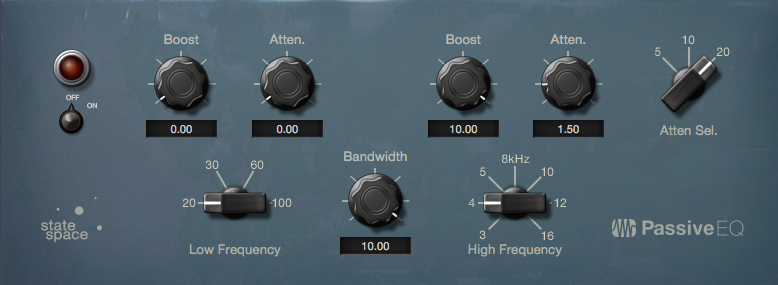An equalizer, or EQ, is a filter that allows you to adjust the volume level of a frequency, or range of frequencies, within an audio signal. In its simplest form, an EQ will let you turn the treble and bass up or down, allowing you to adjust the coloration of, let’s say, your car stereo or your television. In professional audio circles, equalization is a highly sophisticated art that can be used to sculpt the tone of instruments in a mix, counteract anomalies in a room, or just pump up the bass.
Regardless of its application, good equalization is critical to a good mix. When used correctly, an equalizer can provide the impression of nearness or distance, “fatten” or “thin” a sound, and help blend or provide separation between similar sounds in a mix, allowing both to be heard as intended. It can also be used to adjust a sound system to account for the acoustical response of a room or an outdoor venue.
This article will explain the functions of two of the most common EQs in use in modern recording and live sound: Parametric and Shelving.



Parametric EQ
The parametric EQ is a mainstay of recording and live sound because it offers continuous control over every parameter. A parametric equalizer offers continuous control over the audio signal’s frequency content, which is divided into several bands of frequencies (most commonly three to seven bands).
You will find parametric EQs in the following configurations:
- Fully Parametric. The 4- and 6-band EQs in the StudioLive™ Series III mixers are good examples of a fully parametric hardware EQs, offering control of the gain (boost/cut) for each frequency band, the center frequency of the midrange bands, and the cutoff frequency for the low and high bands. A fully parametric EQ offers continuous control of the bandwidth, which determines the range of frequencies affected, or control over the Q, which is the ratio of the center frequency to the bandwidth. For most purposes, a Q control accomplishes the same thing as a bandwidth control but the two are not identical. More on that in a minute.

- Semi-Parametric. On a semi-parametric EQ, like the 3-band EQ available on the stereo channels of the StudioLive AR-series mixers, the gain and frequency are adjustable but the Q and bandwidth are fixed at a preset value.

- Quasi-Parametric. A variation on the semi-parametric is the quasi-parametric EQ, which typically provides full frequency and gain adjustment but only two or three Q settings. The EQ in the StudioLive 16.0.2USB digital mixer’s Fat Channel is an example of a quasi-parametric EQ, offering a simple choice of high or low Q settings for the mid band.

Understanding Q
In equalizers, Q is the ratio of center frequency to bandwidth, and if the center frequency is fixed, then bandwidth is inversely proportional to Q—meaning that as you raise the Q, you narrow the bandwidth. Q is by far the most useful tool a parametric EQ offers, allowing you to attenuate or boost a very narrow or wide range of frequencies within each EQ band.
A narrow bandwidth (high Q) is particularly useful for removing unpleasant tones. Let’s say the snare drum in your mix has an annoying ring. With a very narrow bandwidth, you can isolate the offending frequency (usually around 1 kHz) and remove, or reject, it. This type of narrow band-reject filter is also known as a notch filter. By notching out the offending frequency, you can remove the problem without removing the instrument from the mix.
A narrow bandwidth is also useful in boosting desirable components of an instrument’s sound, such as the attack on a drum. For instance, a kick drum resonates somewhere between 60 to 125 Hz, but the attack of the kick drum is much higher, at 2 to 5 kHz. By setting a narrow bandwidth and boosting the attack a bit, you can achieve a punchier kick drum without overpowering the rest of the mix.
A broad bandwidth accentuates or attenuates a larger band of frequencies. Broad and narrow bandwidths (low and high Q, respectively) are usually used in conjunction with one another to achieve the desired effect. Let’s look at our kick drum again. We have a kick drum that has a great, big, low-end sound centered around 100 Hz and an attack hitting almost dead-on at 4 kHz. In this example, you would use a broad bandwidth in the low-frequency band, centered at 100 Hz, and a narrow bandwidth boosted at 4 kHz. In this way, you are accentuating the best and downplaying everything else this particular kick drum has to offer.
 The quasi-parametric EQ on the StudioLive AR-series mixers’ mono channel provides a unique “asymmetric” Q design in which, while the Q is fixed, the Q narrows when the signal is cut to provide a notch filter, but broadened when the signal is boosted to provide more musical enhancement for sonic shaping.
The quasi-parametric EQ on the StudioLive AR-series mixers’ mono channel provides a unique “asymmetric” Q design in which, while the Q is fixed, the Q narrows when the signal is cut to provide a notch filter, but broadened when the signal is boosted to provide more musical enhancement for sonic shaping.
Shelving EQ
A shelving EQ attenuates or boosts frequencies above or below a specified cutoff point. Shelving equalizers come in two different varieties: high-pass and low-pass. Low-pass shelving filters pass all frequencies below a specified cutoff frequency, while attenuating all the frequencies above the cutoff. A high-pass filter does the opposite, passing all frequencies above the specified cutoff frequency while attenuating everything below. Usually, the frequencies beyond the cutoff are rolled off, following a predetermined curve, not cut off sharply, as with a “brickwall” filter.
Some multiband parametric EQs offer low and high bands that can be switched to shelving filters. In others, such as the EQ in the Studio Channel, the low and high bands are shelving filters, while the mid band is fully parametric.












